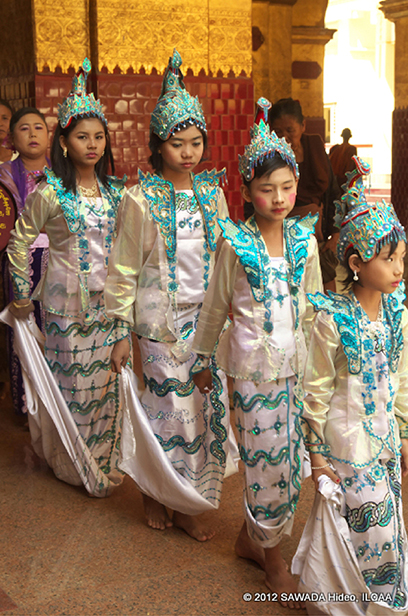Monthly Photos April 2012
Photos taken by ILCAA staff and associates are posted here once a month; most of them are taken during their field research in Asia and Africa.
(The copyright belongs to the photographers.)
The girls to attend the ear-piercing ceremony
The ear-piercing ceremony (Na-htwin-bwe) is the initiation ceremony for Burmese girls, corresponding to monk novitiation ceremony (Shin-byu-bwe) for boys. It was a royal custom to pierce ears with a golden needle so as to wear jeweled earrings. Especially it was compulsory for princesses to have their ears pierced before getting married. The ear-piercing ceremonies mainly found in cities nowadays might be the inheritance of the royal custom.
The picture was taken at Maha-muni, the principal pagoda in Mandalay. The girls dressed in goddess costume was walking behind the boys wearing prince costume, who are outside of the picture. According to an anthropologist acquaintance of mine, the picture is a scene of the procession which depart from the pagoda to the place of the novitiation and ear-piercing ceremonies.
Careful readers must be aware that some of the girls have already worn earrings before the ear-piercing ceremony. It is a recent trend, I heard, that girls have their ears pierced in early childhood and simply dress up in the `ear-piercing' ceremony. Obviously the original meaning of the ceremony has come to be lost sight of. At first I thought that it is because originally the ceremony is not well-supported by the tradition of Buddhism like the novitiation ceremony. In fact, it is said that even novitiation ceremonies are now simplified in urban area.
Changes certainly occur also in the country where it has been thought that the time crawls along.

28 FEB 2012
At Maha-muni Pagoda, Mandalay, Myanmar
Photograph by Hideo SAWADA
Copyright © 2010 Research Institute for Languages and Cultures of Asia and Africa. All Rights Reserved.
